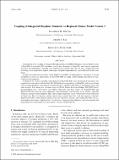| dc.contributor.author | Winter, Jonathan (Jonathan Mark) | |
| dc.contributor.author | Pal, Jeremy S. | |
| dc.contributor.author | Eltahir, Elfatih A. B. | |
| dc.date.accessioned | 2010-03-03T16:20:45Z | |
| dc.date.available | 2010-03-03T16:20:45Z | |
| dc.date.issued | 2009-05 | |
| dc.date.submitted | 2008-09 | |
| dc.identifier.issn | 0894-8755 | |
| dc.identifier.uri | http://hdl.handle.net/1721.1/52008 | |
| dc.description.abstract | A description of the coupling of Integrated Biosphere Simulator (IBIS) to Regional Climate Model version 3 (RegCM3) is presented. IBIS introduces several key advantages to RegCM3, most notably vegetation dynamics, the coexistence of multiple plant functional types in the same grid cell, more sophisticated plant phenology, plant competition, explicit modeling of soil/plant biogeochemistry, and additional soil and snow layers.
A single subroutine was created that allows RegCM3 to use IBIS for surface physics calculations. A revised initialization scheme was implemented for RegCM3–IBIS, including an IBIS-specific prescription of vegetation and soil properties.
To illustrate the relative strengths and weaknesses of RegCM3–IBIS, one 4-yr numerical experiment was completed to assess ability of both RegCM3–IBIS (with static vegetation) and RegCM3 with its native land surface model, Biosphere–Atmosphere Transfer Scheme 1e (RegCM3–BATS1e), to simulate the energy and water budgets. Each model was evaluated using the NASA Surface Radiation Budget, FLUXNET micrometeorological tower observations, and Climate Research Unit Time Series 2.0. RegCM3–IBIS and RegCM3–BATS1e simulate excess shortwave radiation incident and absorbed at the surface, especially during the summer months. RegCM3–IBIS limits evapotranspiration, which allows for the correct estimation of latent heat flux, but increases surface temperature, sensible heat flux, and net longwave radiation. RegCM3–BATS1e better simulates temperature, net longwave radiation, and sensible heat flux, but systematically overestimates latent heat flux. This objective comparison of two different land surface models will help guide future adjustments to surface physics schemes within RegCM3. | en |
| dc.description.sponsorship | International Centre for Theoretical Physics | en |
| dc.description.sponsorship | Linden Fellowship | en |
| dc.description.sponsorship | National Science Foundation | en |
| dc.language.iso | en_US | |
| dc.publisher | American Meteorological Society | en |
| dc.relation.isversionof | http://dx.doi.org/10.1175/2008JCLI2541.1 | en |
| dc.rights | Article is made available in accordance with the publisher's policy and may be subject to US copyright law. Please refer to the publisher's site for terms of use. | en |
| dc.source | American Meteorological Society | en |
| dc.title | Coupling of Integrated Biosphere Simulator to Regional Climate Model Version 3 | en |
| dc.type | Article | en |
| dc.identifier.citation | Winter, Jonathan M, Jeremy S Pal, and Elfatih A. B Eltahir. “Coupling of Integrated Biosphere Simulator to Regional Climate Model Version 3.” Journal of Climate (2009): 2743-2757. © 2009 American Meteorological Society | en |
| dc.contributor.department | Massachusetts Institute of Technology. Department of Civil and Environmental Engineering | en_US |
| dc.contributor.approver | Eltahir, Elfatih A. B. | |
| dc.contributor.mitauthor | Winter, Jonathan (Jonathan Mark) | |
| dc.contributor.mitauthor | Eltahir, Elfatih A. B. | |
| dc.relation.journal | Journal of Climate | en |
| dc.eprint.version | Final published version | en |
| dc.type.uri | http://purl.org/eprint/type/JournalArticle | en |
| eprint.status | http://purl.org/eprint/status/PeerReviewed | en |
| eprint.grantNumber | EAR-04500341 | en |
| dspace.orderedauthors | Winter, Jonathan M.; Pal, Jeremy S.; Eltahir, Elfatih A. B. | en |
| mit.license | PUBLISHER_POLICY | en |
| mit.metadata.status | Complete | |
